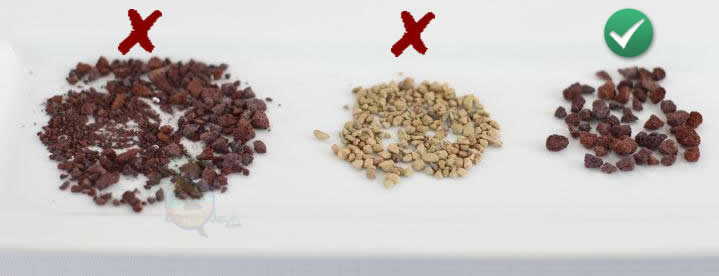Originally posted 1-13-2014
Not all aggregates are created equal.
Sourcing aggregates for bonsai can be difficult. It can be
even harder to locate the proper sized aggregate. Hundreds of sellers offer
some sort of aggregate intended for bonsai trees. Many of these aggregates are
not ideal for your tree.
The biggest mistake we see is the use of aggregates that are
too small or too big. The ideal size material for most bonsai trees is 1/8th
to 3/8ths inch. This will result in material that averages ¼ inch.You want 1/4 sized material in your trees.
Here is an image showing particles that are too small.

that contains 1/8th inch minus all the way down to dust.
is generally too small for most bonsai
Quarter inch lava.
Here is another image showing particles that are too large.
size pumice
inch ideal sized lava rock
improperly sized lava rock
There are exceptions to every rule. This image shows 1/8th
inch shohin/mame sized aggregates used ONLY for micro sized trees.
Black 1/8th lava
unsifted Turface MVP
inch pine bark fines
When purchasing lava, pumice, turface, or pine bark fines
you should know the exact size the seller is offering. If the size is not
clearly stated in the description its best to avoid that seller
Don’t make the $5 mistake. Buyers often see a bag of
material that is selling for $5 less than the name brand product. Some of these
sellers will offer a box of material that is ½ inch all the way down to dust. Leaving
you with about 33 percent of usable material.
Lets look at the numbers. A name brand ¼ inch lava rock is
selling for $30. A box of unsorted lava is selling for $25. Both are three
gallons. Lets assume the $25 box has a 33 percent yield of ¼ inch material
leaving you with 1 gallon of useable material. You have just spent $25 for one
gallon of bonsai grade lava rock. You will need to buy three bags(9gallons total) of
the $25 lava to make one 3 gallon bag of usable material. In the end that 3
gallons will end up costing you $75 when you could have simply bought the $30
3-gallon bag of reputable material in the first place.
The above figures show you what we, as an aggregate vendor,
deal with on a regular basis. We receive this raw unsorted material in bulk.
The material is sifted using a custom high speed sorting block. Whatever
material is above 3/8ths is crushed and resorted. Anything below 1/8th
to 1/16th is cleaned and processed for mame and shohin sized trees.
The remaining material is disposed of.
Another factor is volume. Two mistakes are often made.
Buying material based on weight is something you want to
avoid. A prime example is montmorillonite (turface). Even though this material
has been calcined it still holds a considerable amount of water. This material
can hold up to 50 percent of its weight in water. Meaning a 10-pound bag can
also weigh 15 pounds depending on the moisture content.
Bonsai lava also holds water. This material can retain as
much as 12 percent of its weight in water. Bonsai Block, 7 percent. Pumice by as
much as 24 percent. Try and stick with a seller who advertises by volume.
Another factor is volume. Many sellers will state the box is
approximately…
The problem is many of these are overstated. We have even
seen sellers offering one half of a cubic foot (864 cubic inches) shipped via
medium flat rate box that is 590 cubic inches. The point is the math doesn’t
always work. Many vendors use funny math that doesn’t always add up. Use caution with estimates and verify the
dimensions. Here are some common USPS flat rate box sizes.
Flat Rate Box Maximum Volume = 834.98 Cubic Inches or 3.61 Gallons.
Flat Rate Box Maximum Volume = 590.62
Cubic Inches or 2.55 Gallons.
Flat Rate Box Maximum Volume = 75.33
Cubic Inches or 1.30 Quarts.
Another
benefit of purchasing from a reputable dealer is the material is often washed.
All of our aggregates are washed before shipping. Several bonsai outlets(not only Bonsai Jack) offer great aggregates that have
been cleaned and dried before shipping. This allows you to make immediate use
of the aggregate.
Notes about turface. We sell this product to the die-hard bonsai
enthusiasts. We do not recommend using turface for your bonsai tree as the
particles are too small and the water retention is too high. If you are one of these
turface consumers please consider switching to Bonsai Block. It has a water
retention rate of about 24 percent by weight and is available in a ¼ inch size.
It’s a very durable material that is constantly sized and retains a natural
stone look. This product will improve drainage of your tree.We will be releasing a 1/4 Bonsai Block product labeled as “Bonsai Block” in the coming months.
Ten
gallons of Turface will only yield about 1 gallon of 1/8th plus material. If you do
purchase this product please do so from a reputable seller. Some sellers will
sort the top 10 percent off for personal use and sell the remaining less
desirable material. Purchase only untouched turface direct from the factory
bag. If its missing all of its 1/8th plus sized material then you have issues.
Turface
is not all bad. It has been used for many years by several bonsai experts. We
still use Turface for Mame and Shohin sized trees. Mixed with 1/8th
lava, and 1/8th pine bark fines it makes a great soil for micro
sized trees.
To recap. You want to find material that …
- Clearly states ¼ inch in size
- Come from a reputable seller
- You want to avoid material that includes the terms fines,
dust, fillers, supplement, 1/32, 1/16, powder or sand. - Avoid material that is smaller than 1/8th or
larger than 3/8ths.
This photo shows what size aggregates you should be using
for your bonsai tree.
inch pumice
inch maroon lava
inch black lava
inch pine bark fines
montmorillonite calcined clay. Turface like, but it has a consistent ¼ size.
Before I close this article out I wanted to touch briefly on
Pumice. Pumice has several grades and valuations. Not all pumice is created
equal. To simplify things you want to avoid pumice with characteristics similar
to perlite. This type of pumice is often advertised as “100 percent floating/ float-able/floated pumice”. If the pumice can be easily split with our fingernails you should
probably avoid it. This type of material with break down pretty fast. Bottom line: If it all floats it all breaks down.
The End



